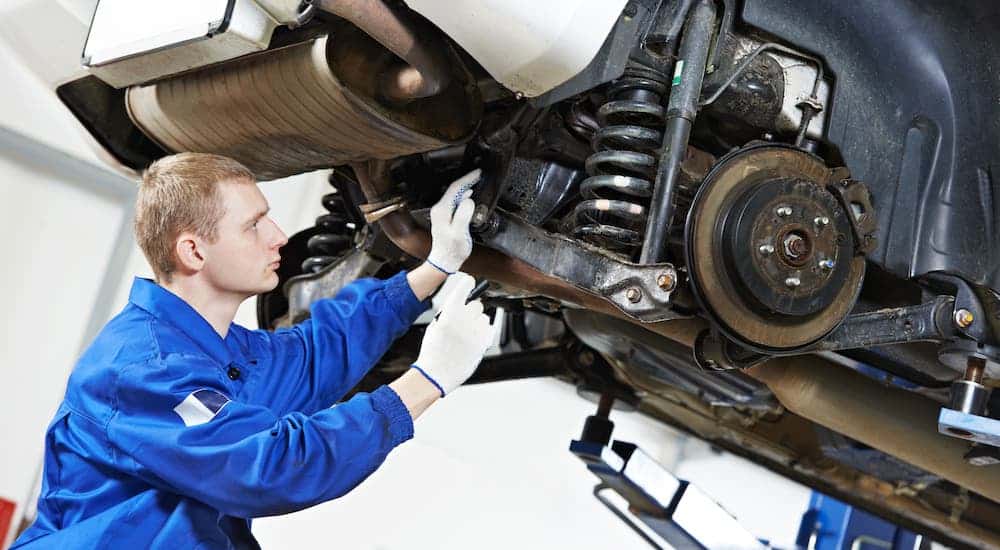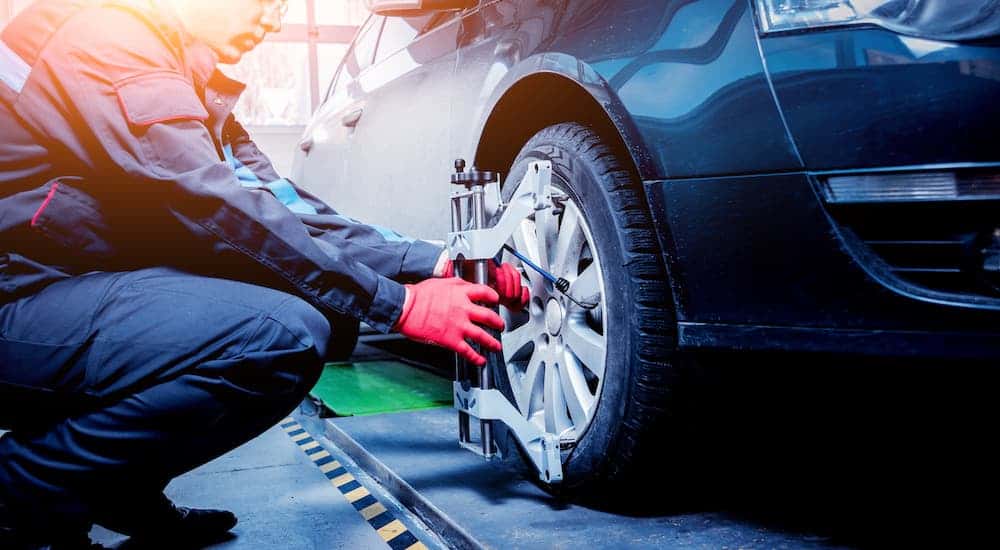Suspension & Steering

Suspension and steering are among the most important and most underappreciated aspects of a car, and proper maintenance of these systems is critical to keeping your vehicle performing as it should. Although technically separate items, a car’s suspension and steering systems are closely related, and lack of maintenance on one can affect the other. This is because suspension does far more than simply provide a smooth ride on bumpy roads. One of the primary purposes of your car’s suspension is to keep all four wheels properly in contact with the road while cornering, accelerating, and braking. And if its suspension is not properly maintained, then a car can become less responsive, slower, and harder to stop.
Springs, Struts, and Shocks
The most important and best known components of automotive suspension are the springs, struts, and shocks. The springs are responsible for supporting the vehicle’s weight while still providing the give needed for a smooth and comfortable ride. Cars and SUVs generally have coil springs while trucks will use leaf springs, there is also a third type of spring known as a torsion bar that is found in some smaller vehicles. Springs do not need to be replaced often, but regular maintenance is crucial to identifying worn springs before they catastrophic failure. If you notice that your vehicle is sagging or handling poorly, it is a sure sign that the springs are wearing out.
While springs are an excellent way to provide the necessary give in a vehicle’s suspension, by themselves, they would give a very bouncy ride. This is why they are paired with struts or shocks to dampen suspension travel. Shock absorbers are bulkier stand alone systems, while struts are integrated with coil springs to provide a compact package. This means that generally, shocks are found on trucks and large SUVs, while struts are mainly used on cars and crossovers. Unlike springs, shocks and struts do need to be regularly replaced, and most vehicles call for them to be changed out somewhere between 30,000 and 60,000 miles. The easiest way to know if your shocks or struts need replacement is by pushing down on your car and seeing if it bounces more than once before it stops moving.
However, given the drop in performance that comes with a worn suspension, it is important that all of these major components are inspected regularly by a qualified mechanic so that items can be replaced before they begin exhibiting obvious signs of wear. Keeping your suspension in top condition not only gives you a more comfortable vehicle, but also a safer vehicle. But while springs, shocks, and struts are the largest and most vital components of your vehicle’s suspension system, they are far from the only items that require regular maintenance.

Control Arms, Ball Joints, and Bushings
The control arms are part of both the suspension and steering systems on your car. They are what attach the wheels to the car body, but the front control arms must also allow the full range of motion needed during steering. In order to meet these requirements, the control arms are a fairly complex piece of engineering and have a few different areas that need to be regularly inspected. The most critical of these are the ball joints that the wheels attach to. Although made out of solid metal, these ball joints can wear out over time or even break off entirely. Because the symptoms of ball joint wear can be subtle, regular inspections by a qualified mechanic are vital to catching this problem before it becomes a potentially catastrophic issue.
On the other end of the control arms are the control arm bushings. These soft rubber fixtures are used in the connections between the control arms and the body of the car and help provide a smooth and quiet ride. However, the control arm bushings are relatively fragile, and if they wear out or are damaged, then the control arms will become loose. This in turn, can lead to imprecise steering that makes the car more difficult to handle or even accelerate wear on other suspension components. But while they are a wear item, bushings do not always have a manufacturer recommended replacement schedule, and regular inspections are the only way to catch worn or damaged bushings before they can become a problem.
Tie Rod Ends and Boots
When you turn the steering wheel in your car, it is the tie rod ends that actually transmit that movement from the steering rack to your front wheels. A loose tie rod end can produce shaking or a sloppy steering feel, and if a tie rod end fails, then you will lose control over your vehicle. However, despite their critical nature, the tie rod ends are actually a fairly fragile component that needs to be regularly checked for wear, and that should be replaced if any issues are found. Fortunately, replacing a tie end rod is a fairly simple and inexpensive process, although the vehicle will require a new alignment afterward.
Part of the reason why tie rod ends need to be checked often is because they usually have one or more soft rubber boots that protect their moving sections from the elements. If these boots fail, then not only can moisture get into the tie rod ends and begin rusting them out from the inside, but the tie end rods can also lose the packed grease that they need to keep moving smoothly without wear. Inspecting these boots for damage is an important aspect of proper steering and suspension maintenance.

Power Steering
Modern vehicles all use a form of power steering in order to make turning the steering wheel effortless. However, this system does need to be maintained to function properly. The most common reason why your power steering system may not be operating as expected is simply a lack of power steering fluid. While the power steering reservoir is easy to check and top off, it is not something that most drivers remember to monitor. However, power steering failures can also be caused by a problem with the power steering pump. This pump is driven by the engine serpentine belt, and an old or worn belt can lead to a power steering failure, alternatively, the pump itself could be at fault and require replacement. As always, regular inspections of the steering system are the key to discovering these potential issues before they can become a problem.
Keep Your Car in Shape
In order to keep your car's suspension and steering systems up to spec, it is important to regularly visit a qualified mechanic. And here at Kings Quick Lane Tire & Auto Center, we understand that simply finding the time to take your car to the shop is one of the largest obstacles to regular maintenance that the average driver faces. That is why we pride ourselves on not only providing top notch service and quality parts to Cincinnati area drivers, but on giving our customers the efficient and hassle free service that they deserve. With our flexible scheduling, you can set up an appointment that fits your needs and ensures that your vehicle receives the care that it deserves without having to rearrange your life. So pay us a visit and make sure that your car, truck, or SUV is running properly because suspension and steering maintenance are not just a matter of comfort but also safety.
